HIDING IN PLAIN SIGHT: Las Vegas Details You Never Noticed
Posted on: January 26, 2024, 02:08h.
Last updated on: June 28, 2024, 09:04h.
There are some interesting details about Las Vegas that even its most seasoned tourists probably never noticed, and that’s because the town doesn’t particularly want them to.
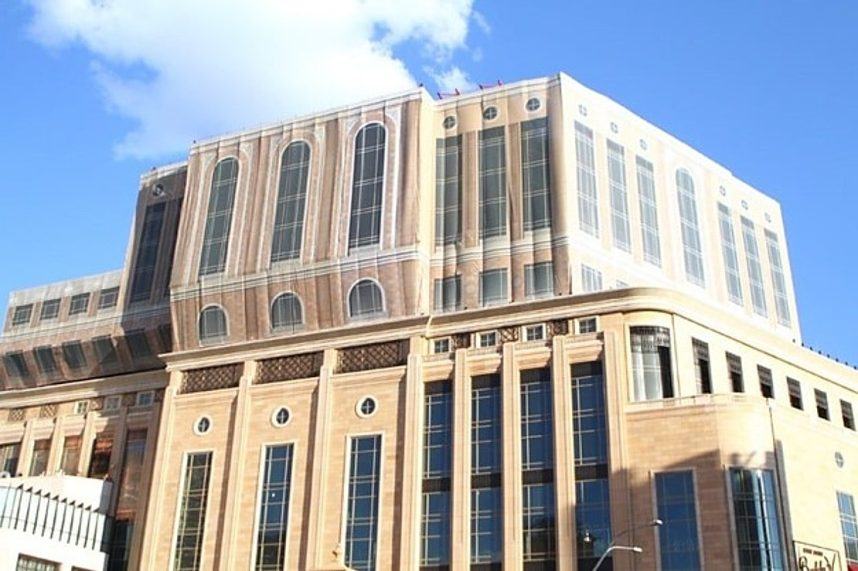
They’re right there, though. You just have to know where to look.
The St. Regis Tower
In 2008, Las Vegas Sands Corp. was busy constructing a third tower — a 50-story condo that would stand between its Venetian and Palazzo properties. Then the Great Recession said, “No, you’re not.”
The financially struggling company had already sunk $180M into the St. Regis Tower, and all three obvious options available to it at that point were equally bad:
1) Paying $600M it no longer had to finish building a slew of million-dollar condos that wouldn’t sell
2) Only slightly less expensively dismantling what it started
3) Allowing several stories of ugly steel framing to rust in the elements, and create negative financial speculation, for who knows how long.
So, Las Vegas Sands invented a fourth option. In 2011, for the cost of $1 million, it covered the exposed framework in an artist’s rendering of a finished building.
Look closely. It’s still there.
The Marina Hotel
In 1989, MGM bought and demolished the Marina Hotel to build its new MGM Grand. The old MGM Grand, tainted by the second-deadliest hotel fire in American history, had by then become Bally’s and, since 2022, has gone by Horseshoe Las Vegas.
Except, MGM never demolished the Marina. It simply gave it a green skin and built the new MGM Grand around it. Few realize that MGM’s west wing once stood alone as this 714-room hotel opened in 1975.
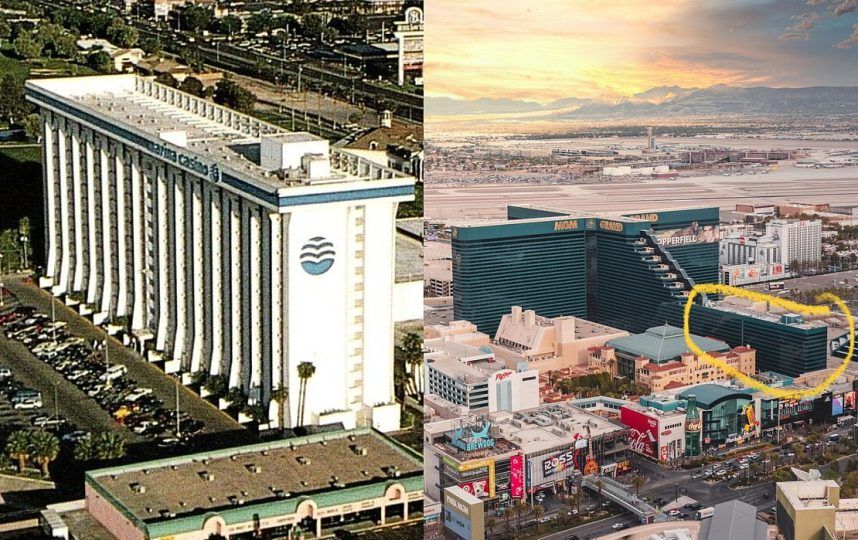
If you’ve ever wondered why the rooms there are smaller and less expensive, now you know.
The Dimmer Luxor Beam
When it opened in 1993, the Luxor light, powered by 39 xenon lights with 7,000-watt bulbs, emitted 42.3 billion candela of light. To put that into perspective, a modern lighthouse emits about 1 million candela. So … 42K lighthouses pointed directly up.
The above paragraph was written in the past tense because the Luxor light has been dimmed by half since 2008. The dimming was implemented by MGM Resorts to save energy and money in the hope that no one would notice.
Except for occasional articles like this that point out the light’s dimming to only the exceptionally bright people who care about such things, it worked. Almost no one noticed. And, even at around 21 billion candela, the ultimate high-beam atop the Luxor is still believed to be the world’s brightest light.
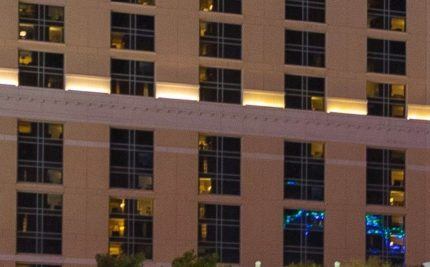
The Window Trick
Architects of many Strip hotels have utilized an optical illusion designed to fool you into thinking that a tower is smaller and, therefore, a shorter walk from your current location on the Strip than it really is.
The Bellagio, for example, appears to have 16 stories, but really, it has 36. That’s because each window on its first four “floors” is a grouping of six-room windows spanning three floors. You can’t really tell unless you look from close up at night, with enough interior lights turned on since the heavily tinted windows obstruct daytime viewing.
For its next 12 “floors,” each Bellagio window serves four rooms spanning two floors.
Treasure Island and Caesars Palace also employ the window trick. And the Wynn and Encore’s spin on it is to place one dividing stripe every two stories.
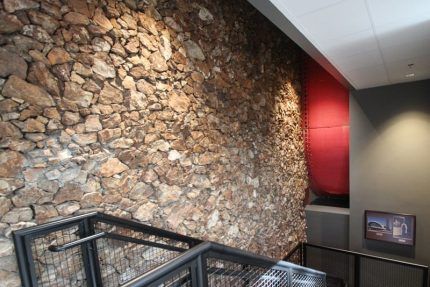
Signs of the Original Mint
In 1988, the legendary Mint downtown was absorbed into the neighboring Binion’s Gambling Hall, then called Binion’s Horseshoe. Binion closed all 365 of the Mint’s hotel rooms in 2009, including Room 1850 in the tower, where most of the action in Hunter S. Thompson’s novel, “Fear and Loathing in Las Vegas,” supposedly took place.
One beyond-intrepid Australian writer recently trespassed on the shuttered tower by taking an elevator to the roof of the adjoining Hotel Apache and climbing down a fire escape.
All we are willing to advise you here is that the lower portion of the original pink Mint sign and an old wood wall from the classic resort can be seen in the stairway leading down to Whiskey Licker Up Saloon at Binion’s.
The Train That Created Las Vegas
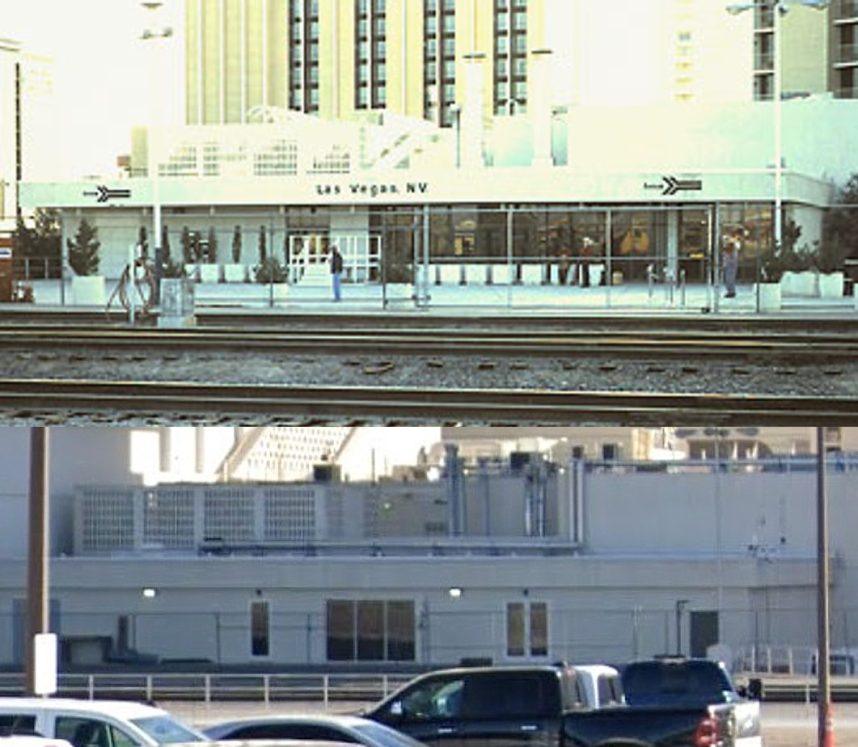
The question occurring to just about everyone driving to Las Vegas for the first time — why this crazy city exists in the middle of nowhere — is answered by the freight trains that diesel alongside Interstate 15, duck underneath it in Sloan, Nev., and chug a couple of blocks west of the Strip, largely unnoticed, before branching northeast to Utah.
Those trains use the original line that once shuttled passengers from LA to Salt Lake City before commercial flights or even mass-produced cars were things.
Las Vegas wouldn’t exist without that rail line.
When the San Pedro, Los Angeles & Salt Lake Railroad was completed in 1905, its owners decided to create a stop halfway through the long haul and build a town to make that stop worthwhile. Las Vegas, named in the 1829 by a Spanish trader after the meadows created by underground springs, would do. It was home only to a few ranches and an abandoned Mormon fort at the time.
The railroad bought the ranches closest to its railroad stop, then sold parcels at an auction on Fremont and Main Streets on May 15, 1905. The first was at 1 Fremont St., which the builder of the Hotel Nevada purchased for $1,750. Today, that hotel still stands as the Golden Gate and still has the town’s very first phone on display. (It’s phone number was “1.”)

The original railroad station was demolished in the late 1930s and replaced with an Art Deco update in 1940. That station was demolished in 1971 and replaced by today’s Plaza Hotel, originally called Union Plaza, in deference to the railroad.
Because passenger trains shared the line with freight trains then, the hotel constructed its own station out back — the only one in the US located inside a casino. By then, the line was run by Amtrak. Its last passenger route from Salt Lake City to Los Angeles, the Desert Wind, was discontinued in 1997 due to low ridership. (Because the tracks were shared, a passenger train stuck behind a freight train could easily take 8 hours from LA to Las Vegas, more than twice as long as driving did.)
Though its branding and furnishings are gone, the Plaza’s Amtrak station still exists by the tracks. It’s now an employee break room and storage area. But an Amtrak mural can still be found between a Subway and a gym at the end of a hallway.
Related News Articles
Fake History: ‘Historic’ Showgirl Sign isn’t the Original
LOST VEGAS: Liberty’s Last Stand Was Not What It Seemed
VEGAS MYTHS RE-BUSTED: You Can Buy Legal Weed On the Strip
VEGAS MYTHS RE-BUSTED: The $20 Room Upgrade Trick
Most Popular
IGT Discloses Cybersecurity Incident, Financial Impact Not Clear
Sphere Threat Prompts Dolan to End Oak View Agreement
This Pizza & Wings Costs $653 at Allegiant VIP Box in Vegas!
MGM Springfield Casino Evacuated Following Weekend Blaze
Most Commented
-
VEGAS MYTHS RE-BUSTED: Casinos Pump in Extra Oxygen
— November 15, 2024 — 4 Comments -
Chukchansi Gold Casino Hit with Protests Against Disenrollment
— October 21, 2024 — 3 Comments -
VEGAS MYTHS RE-BUSTED: The Final Resting Place of Whiskey Pete
— October 25, 2024 — 3 Comments
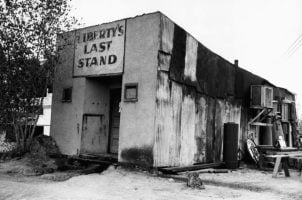
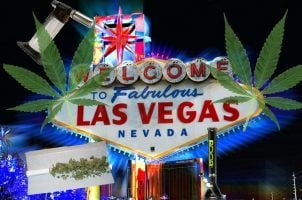











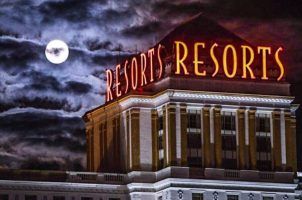

Last Comments ( 2 )
should've figured vegas is tricking up! but some of these are wild!
Great article and interesting stories. Well done